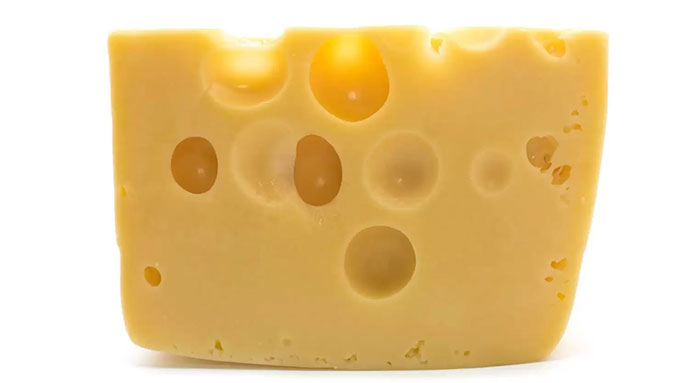Why are there holes in the cheese?
The team of scientists in Switzerland has explained the reason why inside the cheese blocks appear holes and the number, the size of it is less and less.
The story of the cheeses in the cheese problem has puzzled scientists for over a century: Why are there holes? Previously, researchers had known that these holes were formed when bacteria called propionibacterium convert alctic acid from milk into CO 2 bubbles. However, for nearly a decade, new batches of cheeses have been getting smaller and smaller in size, while the cheese makers themselves are unknown.

The holes are often seen in cheese.
Therefore, researchers at Agroscope Agricultural and Food Laboratories, Switzerland, focused on understanding the problem. They eventually discovered that the bubbles of carbon dioxide that formed surrounded the solid particles of the material contained in milk . In the past, when the level of science and technology of milk processing was not developed as it is now, farmers often milked cows in rudimentary barns and there, small particles would fall into the milk carton. In that gas over the last decade, the milk treatment process has become more stringent to ensure hygiene and therefore, milk buckets are no longer "open" for tiny particles to fall in.
After deliberately adding tiny amounts of milk originating from farms and bringing it to cheese, the researchers found that it was clear that the number of small grains was proportional to the number and size of the cheese. holes in the cheese lumps form."No one can deny the fact that propionibacterium converts lactic acid to CO 2. Switzerland is thought to be home to dust particles, " said John Jaeggi, a scientist at the University of Wisconsin Center for Dairy Research . or the dough forms in a curd-like structure . This combines with the gas to form and form the eyes of the cheese. "
The results of this study explain a long-standing mystery that even Swiss scientists and experts scratched their hair on the question " Why has Swiss cheese always been so flawed? " However, Jaeggi insists that tiny particles do not make the cheese unsanitary and they can be found in almost all other foods. So, instead of being scared of the results, enjoy a century-long scientific secret that has been scientifically explained while sipping nutritious cheese.
- Why do some cheeses smell so terrible to smell?
- Believe it or not, this color of cheese turns out to be a 'century trick'.
- Why do cheese have holes?
- Li explained the phenomenon of ear holes stinking ... rotten cheese that anyone wears advice also
- Electricity production from cheese, serving 1500 people
- Homemade cheese from bacteria in ... armpits, human legs
- Why do some types of cheeses smell so badly?
- Exotic delicious cheese made from coal
- Believe it, this color of cheese turns out to be a
- Nobody knows how English people produce fat cheese
- Calcium is 7 times higher than milk, it's a pity not to eat this food
- 3,200 year cheese contains deadly bacteria in Egyptian tombs
- Amazing journey from cow's milk to the world's most addictive food!
- 3600 year old cheese on ancient mummy
 'Fine laughs' - Scary and painful torture in ancient times
'Fine laughs' - Scary and painful torture in ancient times The sequence of numbers 142857 of the Egyptian pyramids is known as the strangest number in the world - Why?
The sequence of numbers 142857 of the Egyptian pyramids is known as the strangest number in the world - Why? History of the iron
History of the iron What is alum?
What is alum?